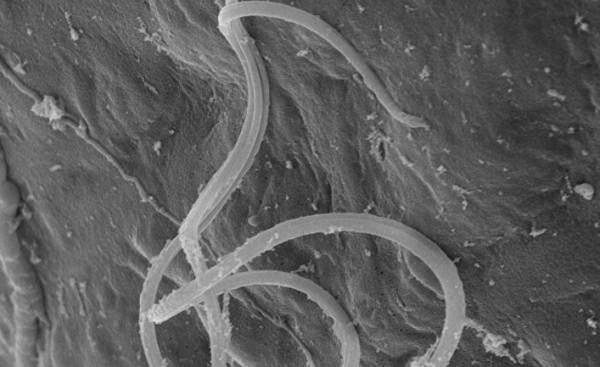
Sperm and eggs of different animals can be incredibly small — much smaller than a human, and can be truly huge, found out the correspondent of BBC Earth. From what it depends and who is the champion?
The sperm is the smallest cell in the human body, and at the same time one of the most difficult. The egg was the biggest, but no less complex.
If we look at what are sex cells (or gametes) have representatives of the animal world, we find that their variety is just amazing.
Most of the species of two gametes, we define them as male and female.
“Gametes have two fundamental functions: a) to ensure a zygote (fertilized egg develops in a species — Approx. transl.) a sufficient supply of nutrients and protective shells, and b) find a gamete of the same species and fertilize them,” explains Matthew gage from the British University of East Anglia.
“To perform equally well both is a Herculean task because each function has its specific features, and requirements affecting both the size and number of cells.”
“On the one hand, germ cells responsible for the survival of the offspring, an important large size with adequate nutritional potential that emerged and developed eggs produced by females,” he continues.
“On the other hand, you need gametes, optimally performs the task of penetration into the egg and fertilized it, so evolution has ensured that sperm produced by males, was enough.”
Why the sperm are so different — in both size and shape? For researchers there is plenty of work.
Logically we can assume that the smaller a living organism, the less his sperm. However, it is not always so. Moreover, the longest known sperm — tiny flies.
Fly Drosophila (Drosophila bifurca) produces sperm in the form of a ball. When scientists were able to let that slide to its full length and measure, it was found that the sperm of a little fly is almost 6 cm Is 20 times longer than the body of the males of this Drosophila.
In a study of 2016 is truly a giant by the standards of Drosophila sperm were compared with the peacock’s tail. That is, he was supposed evolutionary have evolved to such lengths due to the fact that females prefer such long.
However, more is not always better. On the other end of the scale is the shortest of the known sperm — wasps-parasitoid, Cotesia congregata. It is less than 7 micrometers (0.0007 of cm).
Says Rhonda snook of the University of Sheffield (UK), there are several possible explanations for such large differences in size of sperm.
Snook research has shown that natural selection has left only the sperm the most optimal for reproduction of shape and size.
It may seem strange that won both the short and long, but it all is determined by the circumstances of a particular biological species — but rather, competition and selection criteria.
When females mate with many males, sperm cells compete with each other, and only the most healthy will win this hard race and fertilizes the egg.
Such conditions have created a lot of variations, including the very long sperm of Drosophila.
As an example of sverhkachestvennoy can cause sperm woodlice, which forms a chain of small capsules, helping each other, and seminal fluid of some flies and beetles, which poisons the sperm of competitors.
One of the common tactics applied by males, is to install copulation tubes, blocking sperm from other males access to the eggs. Kapustina tube is used by spiders, bumblebees, squirrels, and even some primates.
But for males, it all comes down to achieving the benefits either through the production of a large amount of semen or small its quantity, but stronger.
The choice depends on several factors such as, the path of which length is required to make sperm or how much energy remains in the male after all the marriage rituals preceding mating.
For example, in the study by 2015 there is speculation that larger mammals produce smaller sperm, as reproductive tract their females are larger in size. And it sounds logical — the more field, the more you need players.
In addition, there is also “the mystery of female choice”: some species the female can choose whose sperm will fertilize her eggs.
“We don’t know much about this process: whether this diversity in shapes and sizes of sperm was the result of this “cryptic female choice”, whether it’s about competition, says snook. But as with most issues facing the science, most likely it is a combination of several factors.”
With a woman’s egg doesn’t make it less difficult.
The largest egg among living things, lays an ostrich. It is 20 times heavier than a chicken egg — its height reaches 15 cm, width 13 cm
The smallest eggs among the birds — less than 7 mm — puts a Hummingbird-bee, the smallest of the hummingbirds.
Tim Berthed from the British University of Sheffield — author of the book The Most Perfect Thing: The inside (and outside) of a bird’s egg (“the Most perfect thing in the world: inside and outside of bird eggs”). According to him, in the world of birds egg size is generally proportional to body size, although there are exceptions.
“The Raven (Corvus corax) and Arctic bird Guillemot (Uria aalge) are similar in body size and weigh approximately 1 kg, he said. — Nevertheless the weight of the eggs of the Raven is only 3% of the weight of females, while the weight of the eggs of the Guillemot is about 12% of the weight of females”.
Berched argues that a key factor in determining which size will eggs of one or other species, is the rate of development of the embryo.
Individuals of those species whose Chicks develop quickly, lay large eggs, he says.
Here it should be noted that we are a bit inconsistent in how you use the word “egg”.
Compare the ovum of the female human, whose diameter is 0.12 mm, with chicken egg length of 55 mm. the Thing is that the egg is not only the egg, he has many other functions.
While women carry their offspring in the stomach, carrying eggs species (e.g., chickens) should provide their children with a sufficient amount of all necessary to develop outside the mother’s body.
For this last create a special structure, which we usually call the egg and the embryo which provides food, water and protection (shell) against external influences.
And it’s not some weird freak of nature — most living creatures (birds, insects, fish) do so.
As noted Berthed, we used an evolutionary trade-offs and variations: for some types of your best option become large eggs, for others — a small but much.
At least one thing is clear: if you want to see the little eggs in the world, you will need a microscope.
According to a review of studies done in 1994 by entomologists at the University of Florida (USA), the smallest eggs are laid the tiny parasites.
It is not surprising that data on such microscopic eggs are extremely hard to find. In the same survey, 1994, referred to a tiny fly-parasitoid Clemelis pullata, which has the smallest eggs known to science: of 0.027 by 0.02 mm.
However, while nobody has yet explored the sex cells of meimaridou, miniature wasps-parasitoids (parasitic riders). These insects are one of the smallest on the planet, from 0.5 to 1 mm long. It is easy to guess that the egg that they lay is very, very small.







